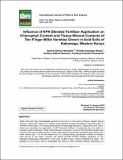| dc.description.abstract | Acidic soils with high exchangeable aluminium ions occur in most parts of Kenya, western Kenya
inclusive. Aluminium toxicity is a serious environmental problem that affects crop productivity in
Western Kenya region. The county governments of Kakamega, Bungoma, Vihiga, Busia and TransNzoia are promoting the application of NPK blended fertilizer to ameliorate the soil acidity to
increase maize production. Finger millet (Eleusine coracana L) is one of the important cereal crops
in Kenya and has the ability to grow under unfavorable environmental conditions much better than
other cereal crops. It is for this reason that it is currently being popularized in efforts to address
food security in the region, however, the effects of NPK blended fertilizer application on the
selected physiological parameters of the crop is little known, hence prompting the study. The
objective of this study was to investigate the effect of NPK blended fertilizer application ochlorophyll content index and plant tissue mineral analysis. Randomized Complete Block Design
with 0,25,50,75,100 kg application rates per acre of NPK blended fertilizer as the treatments were
applied in two equal split applications. The measured parameters were chlorophyll content index
using CCM-200 spectrophotometer, (Opti- Sciences Inc., Hudson, USA) from the plant leaves at
50% plot maturity. Motsara and Roy Procedures were used to determine plant tissue analysis for
nitrogen, phosphorus, potassium, calcium, and magnesium at physiological maturity from the
leaves. Data were subjected to analysis of variance (ANOVA) using GenStat statistical package
version 15.1. Means were separated by Least Significant Difference (LSD) test at 0.05 probability
level. Regression analysis was used to estimate the relationship between variables. At the 75
kg/acre rate, the leaves showed the significant P<0.05 chlorophyll content, calcium, and potassium
in both varieties for the two seasons, short rain, and long rain respectively. Control had the lowest
physiological activities for both seasons regarding chlorophyll content, tissue calcium, magnesium,
nitrogen, phosphorus, and potassium. Significant nitrogen content was observed on Gulu-E variety
for both seasons on the highest rate whereas the same trend was observed on P-224 variety and
during the short rainy season, a linear increase was observed with increasing NPK blended
fertilizer rates. No conclusive pattern was observed during the short rainy season but with the
control exhibiting the lowest phosphorus content for both varieties. A significant response to
physiology (chlorophyll and plant leaf tissue mineral) might have been due to increased uptake of
mineral nutrients present in the NPK blended fertilizer and increased soil pH caused by the liming
action of the NPK blended fertilizern | en_US |

